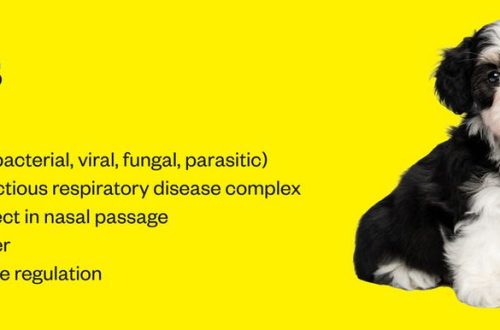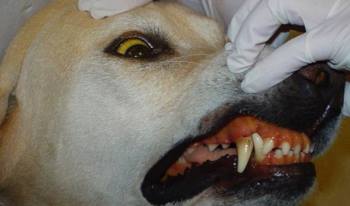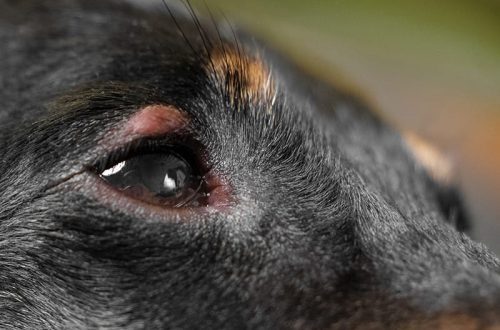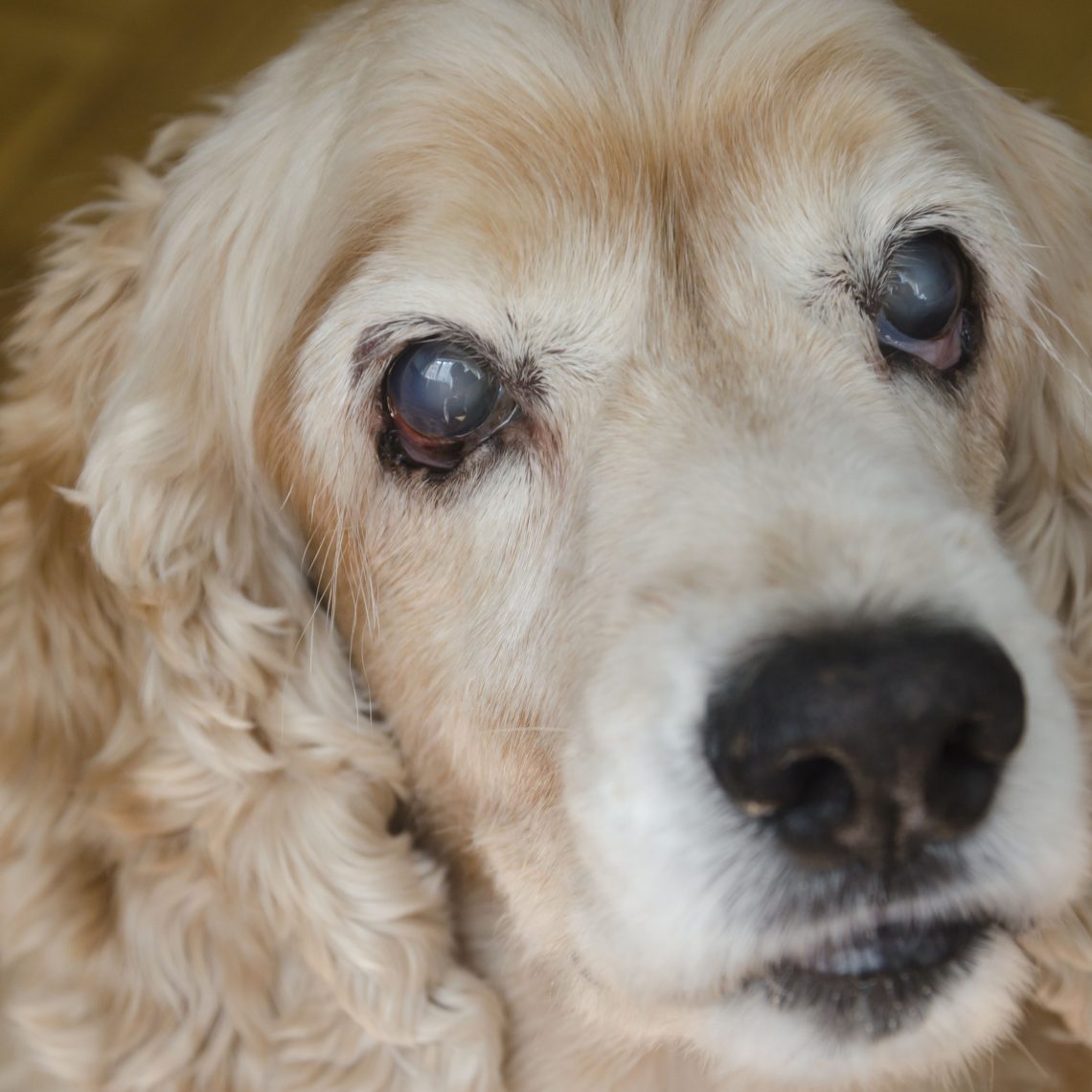
The dog has cloudy eyes – why and how to treat?
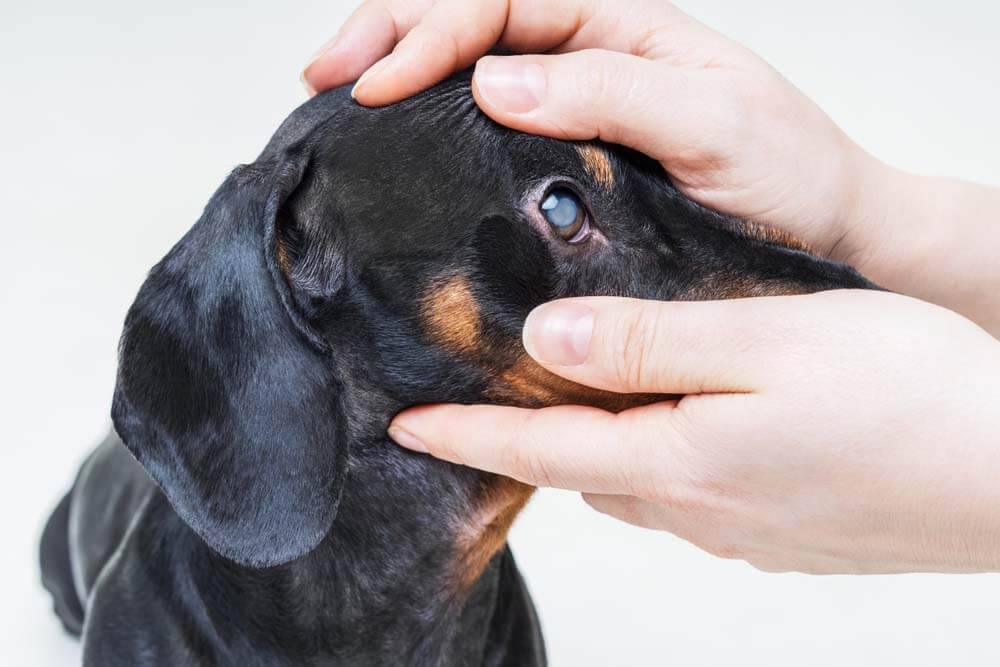
Contents
Possible Causes of Cloudy Eyes in Dogs
In the eyes there are structures that normally should be absolutely transparent – these are the cornea, lenses and intraocular fluid. If any of these structures changes its color, there is a violation of the integrity of the tissues or there is a deposition of pigments in them, then the transparency of the eye changes, and we can see clouding.
The cornea is the outer transparent layer of the eye that transmits light to the posterior segment of the eye. It is transparent because it has no vessels, nerves, pigments. If a corneal injury occurs, or its cells stop updating, it becomes cloudy, and the eye becomes bluish. Turbidity can be local (a white spot on the eye) or total, when the eye is completely cast blue.
The lens is a dense lens that lies just behind the pupil. It is held by thin muscles, due to which, when the muscles contract or relax, its curvature changes. As a result of this process, the eye can see objects at different distances. Since light also passes through the lens to the back of the eye, it is normally transparent. If a pathological protein begins to form inside the lens, the integrity of its capsule is violated, or it itself changes its position and breaks away from the muscles, the eye becomes cloudy.
The intraocular fluid is a very important component for the normal functioning of the eye. It regulates intraocular pressure, nourishes all the internal structures of the eye – the lens, cornea, trabecular apparatus, vitreous body. With the development of inflammation, extensive bleeding, the liquid changes its color, the dog’s eyes become cloudy.
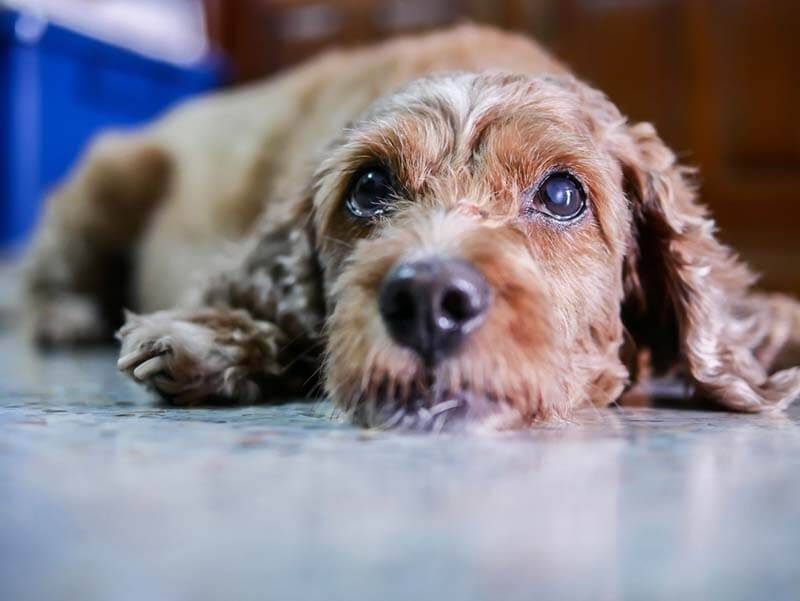
Keratitis
Keratitis is an inflammation of the cornea. Causes can be trauma, a foreign body in the eye, a viral disease, or a bacterial infection. The main symptom of this disease in dogs is clouding of the cornea. It develops as a result of edema, and it happens very quickly, in just a few hours. Keratitis is often underestimated, although it is a fairly serious disease that can lead to blindness. In addition to turbidity, the eye turns red, a tear is plentifully released from it, the dog scratches and squints it.
Ulcers and erosions of the cornea
If a dog has a sharp cloudy eye, the cause is most likely corneal erosion. Erosion is a superficial injury that affects only the upper epithelium. With an ulcer, the deep layers of the cornea – the stroma – are damaged. The injury can be accidental—for example, from playing with another dog, fighting with a cat—or inevitable—if the dog has abnormal eyelashes, droopy eyelids, eye growths, or a lack of tears. In addition to turbidity, symptoms such as blepharospasm (squinting of the eye), lacrimation, redness of the conjunctiva appear at the site of injury. The dog experiences severe pain with corneal ulcers, so it often becomes depressed, its appetite decreases. Corneal injuries are most susceptible to dogs with bulging eyes – Pekingese, pugs, bulldogs. This is due to the fact that they rarely blink due to the structure of the eyelids and eyes.
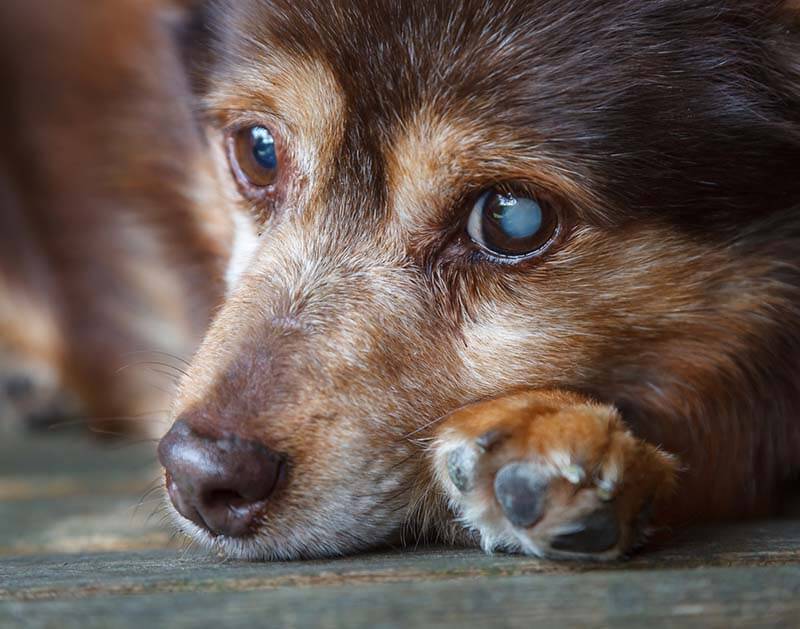
Uveit
Uveitis is an inflammation of the choroid of the eye. The vascular membrane lines the inside of the eye like a cobweb and, in fact, forms vessels with blood. Uveitis can occur as a result of external trauma – a blow to the eye, corneal trauma, or internal diseases – viral and bacterial, as well as parasites and neoplasms. Symptoms of uveitis are not always the same, it all depends on which parts of the eye have undergone an inflammatory process. The eye may turn red, there will be profuse lacrimation. The dog will be afraid of light, due to edema, the cornea will become cloudy. The eye, as a rule, hurts a lot, which causes miosis of the pupil. This is a condition in which the pupil contracts, becomes a small dot, and no longer dilates. The eye becomes cloudy not only due to corneal edema, but also due to the turbidity of the intraocular fluid. And it can become cloudy as a result of the release of inflammatory cells from the vessels or pus in the anterior chamber of the eye. Intraocular pressure decreases, and the eye visually becomes less healthy.
Panophthalmitis
It develops against the background of advanced uveitis or lack of treatment for injuries. For panophthalmitis is characterized by purulent inflammation of all the membranes of the eye. In addition to visible symptoms – cloudiness, redness, increase in size, discharge of pus or blood in the anterior chamber of the eye, the dog has a fever, no appetite, and activity decreases. Over time, the eye dies and vision loss occurs. Unfortunately, even active treatment may fail and the affected eye is removed.
Glaucoma
Glaucoma is a complex disease that results in an increase in intraocular pressure. It proceeds with acute pain and a bluish film on the eyes. The eye increases in size and protrudes from the orbit. Cloudy eyes in a dog indicate critical pressure indicators and that the condition requires urgent medical attention. The disease is hereditary or is a complication of systemic diseases such as diabetes, hypertension, advanced uveitis. The most predisposed breeds are Beagles, Huskies, Hounds, Spaniels, Dalmatians, Samoyeds and Labradors.
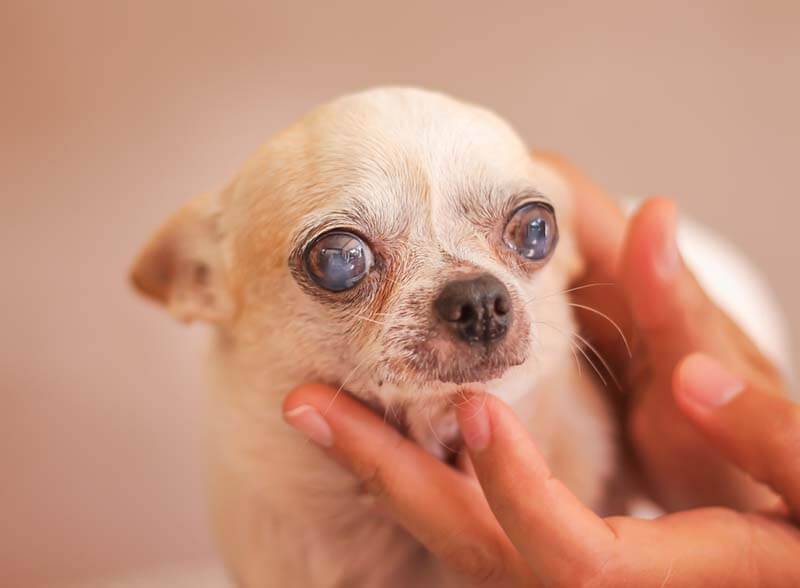
Corneal dystrophy
A hereditary disease in which a dog has a white spot on one eye or symmetrically on both. In the place of turbidity in the cornea, metabolic processes are disturbed, and it dies. Usually the dog has no other complaints – it is active, there is no discharge from the eyes and there is no pain. However, if the lesion worsens, the cornea may tear.
Cataract
The disease develops due to the deposition of protein inside the lens, so it partially or completely turns white. It looks like the dog has cloudy pupils. The clouding process is slow and painless, the lens increases in size and swells. Protein can be deposited as a result of genetic predisposition, uncontrolled diabetes, trauma. Cataracts are hereditary. Predisposed breeds – Jack Russell Terrier, Cocker Spaniel, Poodle, Retriever, Schnauzer.

Luxation of the lens
This pathology in a dog is associated with clouding and displacement of the lens from its normal position. The lens detaches from the ligaments that hold it and moves into the anterior or posterior chamber of the eye. Due to the displacement, the nutrition of the lens is disturbed, and it becomes cloudy. Breed predisposition to lens displacement is found in Chinese Crested Dogs, Jack Russell Terriers, Tibetan Terriers, and Wire Fox Terriers.
Pannus
This is superficial shepherd keratitis, caused by the rejection of the cornea’s own cells. It manifests itself as clouding and violation of the contour of the cornea. Usually it is a bilateral, symmetrical lesion. If left untreated, the cornea turns black and the dog goes blind. The provoking factor of the disease is ultraviolet, so the exacerbation of the disease, as a rule, occurs in spring and summer. The disease is mainly manifested in shepherd dogs – German, Belgian, Australian and mestizos.
Uveodermal syndrome
A rather rare syndrome in which granulomatous uveitis and depigmenting dermatitis develop simultaneously. The dog has a veil on his eyes, uveitis develops and the nose mirror, paw pads, eyelids, lips, hair on the muzzle begin to inflame and turn white. Skin lesions usually appear later than the eyes. It occurs in Akito dogs, Alaskan Malamutes, Australian Shepherds, Basset Hounds, Chow Chows, Dachshunds, German Shepherds, Irish Setters, Old English Shepherds, Samoyeds, Shelties, Shiba Inu, Siberian Huskies, St. Bernards. The disease leads to blindness and requires aggressive complex treatment from dermatology and ophthalmology.
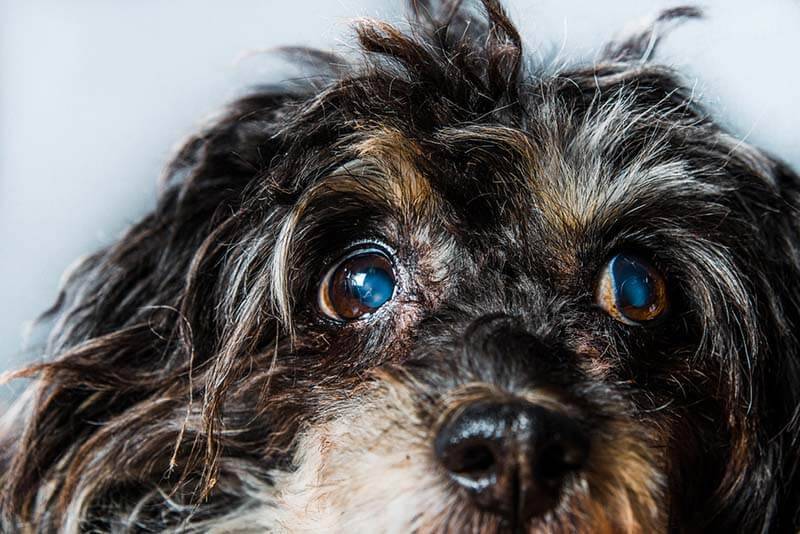
Diagnostics
If you notice that your dog’s eyes have become cloudy, you should immediately contact your veterinary ophthalmologist. The specialist will perform an examination and examination of the eye to make a diagnosis and prescribe treatment.
The ophthalmic examination includes:
Eye examination and reflex testing. Corneal reflexes are checked – if the cornea is weakly sensitive, this may indicate the development of inflammation (uveitis, panophthalmitis, keratitis) and pupillary reflexes – a violation of pupil contraction may indicate the development of inflammation, increased intraocular pressure or acute pain.
Cornea staining. If the cornea is not damaged, special ophthalmic dyes are applied to the eyes. When blinking, the dye is washed out, and if there are ulcers or erosions on the cornea, then the dye brightly stains them. So the doctor can assess the depth and extent of the lesion.
Measurement of intraocular pressure. With the help of a special veterinary apparatus – a tonoveta, an ophthalmologist can measure intraocular pressure, which will make it possible to make diagnoses such as glaucoma – when determining high pressure, or uveitis – when pressure is low.
Ophthalmoscopy. This is a study of the back shell of the eye – the retina, using a special apparatus. With it, you can examine the optic nerve head, evaluate the vessels that feed the eye. The study allows you to evaluate the visual function of the eye and the consequences of diseases such as glaucoma, uveitis, uveodermal syndrome.
Eye ultrasound. The study will allow you to assess the size and position of the lens in cataracts and luxation.
Genetic tests are needed for certain breeds of dogs for the carriage of genes for diseases such as pannus, uveodermal syndrome, lens luxation, cataracts.
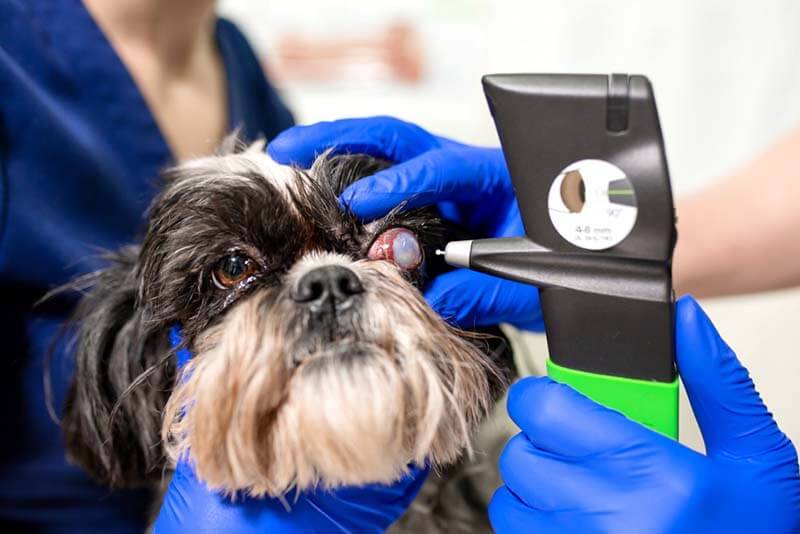
Treatment
The treatment of the disease very much depends on its cause and the time of the visit to the doctor. In ophthalmic problems in dogs, which are symptomatic of cloudy eyes, one of the most important points for successful treatment is early detection of pathology. If the diagnosis is made at an early stage, most problems can be solved with therapeutic treatment – drops and ointments. In advanced stages, surgery is required.
Corneal treatment with keratitis and ulcers most often requires removing the cause of the problem and healing the cornea with moisturizing drops and antibiotic drops. If the damage is superficial and fresh, the treatment gives results quite quickly, and there will be no consequences of injuries in the future. If the condition is neglected, and the ulcers are deep, surgical intervention is necessary. First, the cornea is cleaned, removing dead tissue and equalizing the edges of the ulcer, then the eye is covered with a protective coating – using the eyelids of a dog or an artificial lens. With deep damage, a scar remains on the cornea in the form of cloudy white spots.
Treatment inflammatory processes inside the eye (uveitis, panophthalmitis) – very long and complex, selected individually for each clinical case. For it, combinations of local drugs and drugs inside are used – antibiotics, hormones, non-steroidal anti-inflammatory drugs.
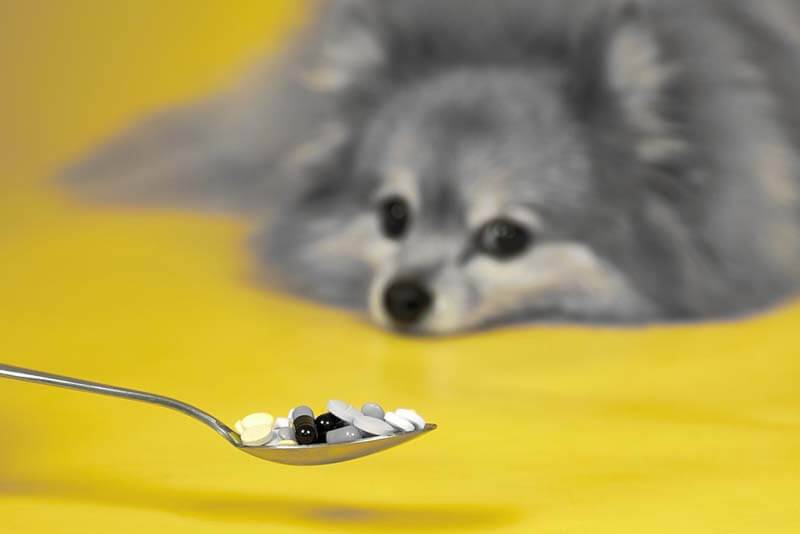
Glaucoma – a very difficult ophthalmological diagnosis. Due to the increase in pressure inside the eye, all structures suffer. The main therapy in the treatment is aimed at controlling the production of intraocular fluid and pressure inside the eye. Assign concomitant drugs to reduce symptoms and reduce the consequences of pressure surges. Unfortunately, therapeutic treatment does not always work, and in this case, surgical correction is performed. If the condition of the dog does not improve after the operation, the eye must be removed.
Any lens changes can only be treated surgically. There are no drugs that penetrate into it, and therefore, there is no possibility of ointments or drops to cure a cataract or strengthen its ligaments. With the development of cataracts, the lens is removed and a new one is installed – cataract phacoemulsification. With luxation, the detached lens is removed, and it is most often impossible to install a new one.
Genetic diseases (pannus and uveodermal syndrome, dystrophies) cannot be cured. In these cases, only supportive therapy is carried out to slow down the development of the disease and improve the quality of life of the pet. Apply hormonal drugs and immunosuppressants (drugs to reduce local eye immunity). Pannus is also prescribed to wear sunglasses for dogs.
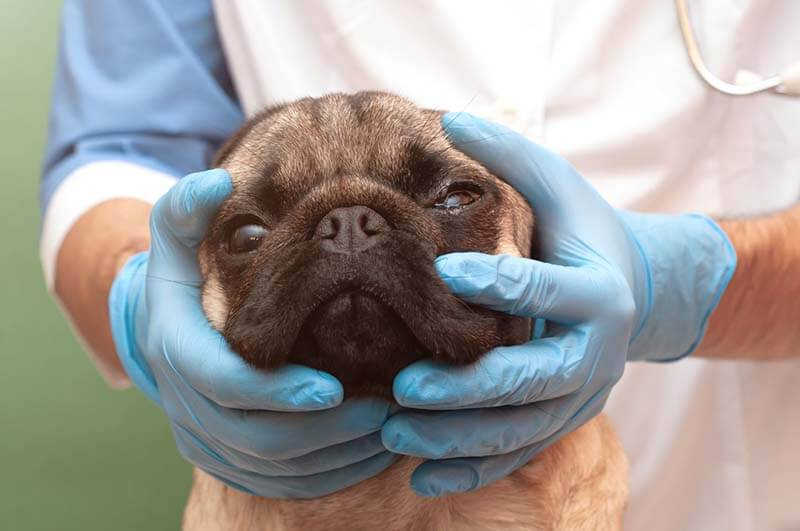
Prevention
Cloudy eyes in a dog is a very serious symptom that threatens with loss of vision. Therefore, it is important to prevent diseases in advance.
Regularly treat for parasites – external and internal, follow the vaccination schedule. Inflammatory processes are often the result of viruses and parasites.
Observe zoohygienic conditions – use complete feeds, monitor the hygiene of the coat, optimal conditions.
Don’t believe the myths. There are many myths about the features of the eyes in different breeds. For example, it is said that it is normal for Spitz to shed tears. Normally, all dog breeds have shiny eyes, transparent corneas, and no excess tears on the coat.
Any changes in the eyes require urgent examination by a veterinarian – redness, bumps, discharge, turbidity. Do not self-medicate.
When choosing a dog find out her pedigree. Look out for eye conditions and request genetic tests from the puppy’s parents to see if they carry an abnormal gene that can cause pannus, luxation, or cataracts.
Examine your dog’s eyes regularly, pay the doctor’s attention to the eyes during any visits to the clinic – for vaccination, trimming of claws or planned medical examination.
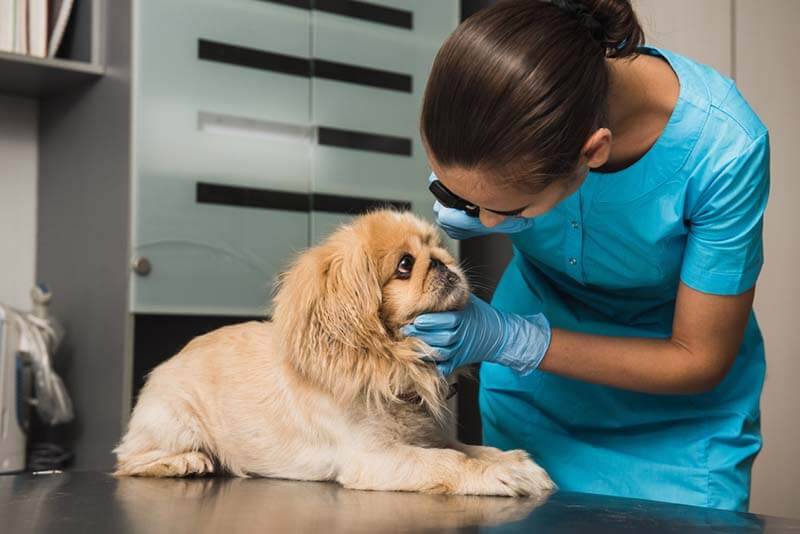
The dog has clouded eyes – summary
If you notice that a dog has cloudy eyes, consider whether this may be a physiological norm associated, for example, with age. Remember how long ago turbidity appeared. In older dogs, cloudiness develops very slowly, and a change in the color and luster of the eyes does not always indicate pathology.
Assess if the dog sees. Shine a light into the eye and see if the pupil contracts. Try taking your dog for a walk in a new area and see how he navigates. Whether she moves carefully, periodically bumping into everything, or confidently explores new territory.
Observe if she has any associated problems – discharge from the eyes, squinting, fear of light and more.
If the dog is purebred, try to find out from the breeders if she was sick in childhood, and if her parents had eye diseases. You can also find out information about the genetic diseases of the eyes of a particular breed on your own.
See a veterinary ophthalmologist for an eye examination immediately if the dog has difficulty seeing, is in pain, has eye discharge, is at risk for genetic disease, or is cloudy very quickly.
Answers to frequently asked questions
December 16 2021
Updated: December 20, 2021



